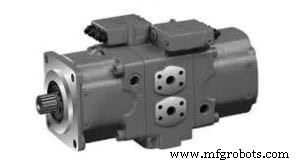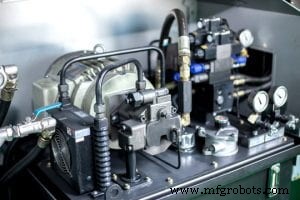什么决定了液压马达的速度
当你想用液压马达移动某物时,你需要知道两件事:流体的速度(以米/秒为单位)和马达的速度(以米/秒为单位)。在本文中,我们将重点关注电机速度并了解它如何影响流体速度。
电动机
电动机根据电磁感应原理工作。旋转电动机由许多电磁铁组成,每极一个。当电流通过电磁铁时,它们会被磁化并绕着自己的轴旋转,彼此相反。这会产生旋转力,可以用来为电动机提供动力。电机的速度取决于它能承载的电流大小和电磁铁的大小。

液压马达
油泵或油斜盘
关于决定液压马达速度的因素存在很多争论。有人说油泵决定转速,也有人说油溅板决定转速。这两种理论都有一定的证据支持,但都不是绝对正确的。
油泵理论基于这样一个事实,即更高的转速需要更高的油流量通过泵。这反过来意味着泵将更加努力地工作,因此,电机将运转得更快。
但是,还有其他几个因素也会影响液压马达的速度。例如,如果油管中有碎屑或电机损坏,它们将无法有效运行,这会减慢它们的速度。此外,温度也会影响电机的运行速度——温度越低,运行速度越慢。
最终,如果不亲自检查液压马达,就无法准确确定它的速度。但是,通过了解各种因素如何影响其速度,您可以确保它以最佳性能运行。
液压马达的速度
液压马达通常比电动马达快,因为液压流体可以更快地移动。此外,液压马达不需要转动很多次即可达到与电动机相同的效果。
然而,液压马达的功率也可能低于电动机。这是因为液压马达没有与电动机相同的功率来产生扭矩。
液压马达通过使用加压流体旋转轴来工作。然后,该轴可用于移动物体或执行任务。
加压流体可以来自储液罐,也可以由发动机提供。储层通常充满油、水或其他类型的流体。
当液压马达通电时,加压流体被迫进入发动机。 This causes the engine to turn and create torque. The torque causes the shaft to rotate and move the object or perform the task.
Compression of the Oil
A hydraulic motor’s speed is determined by how much compression the oil can withstand before it ruptures. The higher the compression, the faster the motor will operate.
Oil compression is measured in psi (pounds per square inch). The higher the psi, the more pressure the oil can withstand before it ruptures.
The maximum oil compression that a hydraulic motor can withstand is around 3000 psi.
If the oil reaches a certain psi level, it can rupture. This can happen suddenly, causing the motor to stop abruptly. Or it can happen over time, with the oil gradually breaking down and becoming unable to withstand the pressure.
Either way, rupture of the oil can be dangerous and lead to a loss of engine power. So it’s important to keep an eye on your oil pressure and make sure it stays within safe limits.
The Output Torque of the Motor
When you buy a motor, it’s important to know the output torque. Output torque is what allows the motor to do its job, and it’s measured in inch-pounds. The higher the output torque, the faster the motor can move objects.
There are a few things that affect output torque. One is the size of the motor. Larger motors have more output torque than smaller motors. Another factor is how quickly the motor can turn. A fast motor has more output torque than a slow motor.
The final factor that affects output torque is the type of fluid inside the motor. Fluids with low viscosity (a thick liquid) have more output torque than fluids with high viscosity (a thin liquid). This is because a low viscosity fluid can flow through a smaller diameter pipe faster than a high viscosity fluid can.
hydraulic motor displacement
A hydraulic motor can be thought of as a piston in a cylinder. The piston is connected to a rotating shaft, and the cylinder is filled with pressurized fluid. The pressure in the cylinder drives the piston, which in turn rotates the shaft.
The size of the piston determines how fast the motor will spin. A small piston will move around quickly, while a large piston will move more slowly. The speed of the motor also depends on how much fluid is inside the cylinder and how tightly the piston is connected to the shaft.
pressure of the oil in the system
The speed of a hydraulic motor is determined by the pressure of the oil in the system. The higher the pressure, the faster the motor will run.
The amount of pressure needed to run a hydraulic motor depends on the type of motor and the size of the system. Typical pressures for various types of motors can be found on the manufacturer’s website. For systems up to 10,000 lb (4,500 kg), a pressure of 40 psi (275 kPa) is typically used. Systems larger than 10,000 lb (4,500 kg) may require higher pressures, such as 50 psi (340 kPa).
esistance to the load being moved
hydraulic motors are typically rated by the number of pounds of pressure that their cylinders can produce. The higher the pressure, the faster the motor will move the load. However, there are other factors that also play a role in how quickly a motor moves a load, such as shaft size and design, number of gears, and motor construction materials.

hydraulic motor
结论
In this article, we will explore the different factors that determine the speed of a hydraulic motor. We will start by looking at the flow rate and pressure drop in a hydraulic system. We will then look at the power input and output of a hydraulic motor, and finally discuss how these factors affect the speed of a hydraulic motor. Hopefully, this article has helped you better understand how to calculate the speed of a hydraulic motor.
工业设备


